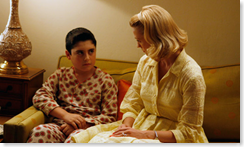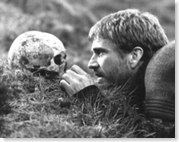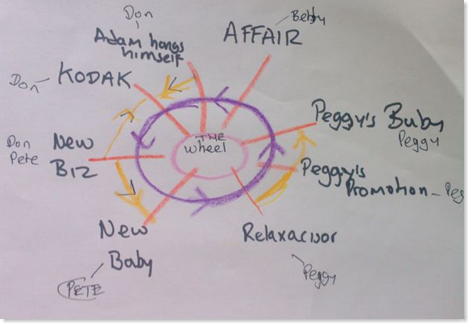Breaking down ‘The Wheel’ episode in Mad Men shows a literary conceit that ties the title into the scenes playing out the cycle of life. In this episode a man dies, a baby is born an affair is revealed and the first woman since WWII is given a copywriter position at Sterling Cooper.
![]()
The ‘problem’ for Don in the story is to figure out how to market Kodak’s new gadget. The end shows Don revealing the slide projector as a time machine to go back and forth through the past and returning to the place where we are loved. We see slides of his kids being born, Christmas day, him and Bets in poses of family love etc. This is a self-revelation for Don and a tragedy at that because he cannot go back and forth like the carousel and save his brother or his marriage. If that weren’t enough, the A, B & C stories tie into this metaphor of the wheel or carousel. This episode is an example of fine writing.
Using the Story Template to determine the A, B & C stories shows that they are not hierarchical. There are more stories, more evenly weighted and they tie into each other with greater meaning. Other episodes tend to have a parallel or mirror story structure where an event in one person’s life is mirrored in another’s and there are clear A, B & C stories.
| Story | Who’s key | What’s it about |
| Kodak | Don | Don has to figure out a way to market the ‘Wheel’ |
| New Biz | Don, Pete, Fellahs | Everyone has to bring in new business. Key to ‘self worth’ |
| Affair | Bets, Francine | Francine tells Bets her hub is shagging Manhattan. This seq is about Bets admitting Don’s affairs to herself. |
| Relaxacisor | Peggy, Ken | Peggy shows command and ability to learn with her account |
| New Baby | Pete, Trudy | Under pressure to provide a grandchild, Pete relents but more to get Clearasil biz from father inlaw |
| Peggy’s Baby | Peggy | Peggy has her (& Pete’s) baby and ignores it. Climactic scene from multi-episode story of her pregnancy. |
| Adam Hangs Himself | Don, Adam | Don tries to reach out to his brother after shunning him. The photos of the two of them together prompt his call to him. |
| Thanksgiving | Don, Bets | Don decides not to join his family for TG, at the end he comes home to go with them to find that it is too late. |
Many of these stories are wonderfully told. In the ‘Affair’ above the writer (Robin Veith and Mathew Wiener) uses Francine’s admission to Betsy about her husband’s philandering as a way for Betsy to confront her own denial about Don. The story is apparently about Francine but is not at all. Bets tells her shrink about Don in a very casual manner but this is a dam burst forth. The cliche would have been. 1) Francine tells Bets she called a manhattan # in their phone bill and got a woman. 2) Bets calls numbers in their phone bill and gets Rachel. 3)Bets confronts Don in angry mess and 4) ‘Hi Jinks ensue’ . Instead, the indirect method is used for greater effect and is more true to the situation. Just because people live in denial doesn’t mean that they will explode at some point. What Bets gets in this story is self-realization ‘I feel sorry for him’ – she has finally figured out what Don’s actions mean.
To arrive at this self-realization is a stunningly beautiful scene in the car park where she goes up to 11 year old Glen and confesses her deepest secret to him ‘I’m so sad’.
 This is her emotional realization of the problem with Don – she can’t quite say it yet only to admit to the depth of it. In the scene with the shrink she intellectual acknowledges it by saying it out loud.
This is her emotional realization of the problem with Don – she can’t quite say it yet only to admit to the depth of it. In the scene with the shrink she intellectual acknowledges it by saying it out loud.
If this series had a subtitle, ‘The tragedy of Don Draper’ would be it. No surprise if this series actually ends with Don ending up on the concrete after a dive from the top floor of Sterling Cooper. The tragedy in this episode is shown beautifully with the Kodak carousel. Don discovers the way to market the product from the realization of his own tragic actions. After telling his brother Adam that he did not want to see him and then after going through old photos makes the call to him only to learn that Adam had committed suicide. Too late for the call. At the presentation with Kodak, clicking through photos of a better life with him and Bets he describes the pain of Nostalgia and here the truth of his life is brought to the surface. Ironically, he calls it the time machine, a device that allows us to go back and forth. But for Don, it is too late. He has lost his brother and now that Bets is aware of his affairs, he will lose her (at least emotionally). The irony, of course, is that he can’t go back in time. This is what makes that last scene so utterly sad and emotionally powerful for the audience. Great stuff.
Robin Veith is certainly a wonderful and intelligent writer. She started as a writer’s assistant with Mathew Wiener on "Mad Men" and no doubt it was her strong visual and literary instincts that got her in as staff writer this season. A writer to watch.
TV doesn’t always connect the A, B & C stories but there’s always a better payoff when it is done with intelligence. Take a look at Hamlet. The A story is about a man seeking to avenge the murder of his father (Hamlet vs. Claudius) and the B story is about a man seeking to avenge the murder of his father (Laertes vs. Hamlet).  How they go about this reveals their values and the problem of the story but essentially the B story informs and affects the A story – as well as reflecting it. The resonance of the B story into the A magnifies the emotional impact on the audience. When the writer uses a strong literary conceit such as ‘The Wheel’ intelligently, the results are outstanding. Why isn’t this seen more often? Because it’s hard to do - well without seeming contrived.
How they go about this reveals their values and the problem of the story but essentially the B story informs and affects the A story – as well as reflecting it. The resonance of the B story into the A magnifies the emotional impact on the audience. When the writer uses a strong literary conceit such as ‘The Wheel’ intelligently, the results are outstanding. Why isn’t this seen more often? Because it’s hard to do - well without seeming contrived.


Great analysis. I think this highlights the fact that Mad Men engages in numerous story telling styles showing a mature writing room.
I think you’re reading WAY too much into this. It’s actually a straightforward A, B & C story and I wouldn’t group the sequences the way you did at all. New Business and Kodak are essentially the same story. Peggy’s baby and the hanging are part of other episode serviced stories. How does Peggy’s promotion tie into the ‘wheel’. I don’t get it.
I do agree with Alex, that the “Wheel” as a story structure is a bit of a stretch. This is a good analysis, and I wanted to emphasize, something you didn’t mention, which is the integration of the theme into the multiple story lines. The pervasiveness of the theme through all the story lines is what really gives the story that “circular” feel. Although you mentioned the “Cycle of Life” metaphor that the “Wheel” creates, that is all it is. It has nothing to do with the structure. It is the theme of The Divergence Between Family and Self (with self pertaining mostly to Business in this story) that is “circular through all the story liens. This theme is weaved into all of the story lines, which gives the “connected” feel to the episode. The conflict is mostly internal within each character and this is one of the reasons it is very emotional and relatable for the viewer.
In the A story, Don realizes through the Wheel and subsequently his Brother’s Death, that he desires to spend more time with his family, resulting in the dream sequence at the end of the episode where he comes home and imagines joining his family for Thanksgiving.
The B story: Betsy comes to terms that Don puts himself over his family, and thus feeling a sadness and isolation for making her family a priority over herself. She is catalyzed my Francine’s revelation, before admitting her denial.
In the C & D stories: Pete is at odds at having a child and beginning a family because it would interfere with his personal/business life. Pete’s struggle between Self & Family is also illuminated by Pete caring more about his father-in-laws business, than spending time with his father in law or having a child at his Father-in-law’s suggestion. Peggy’s absolute rejection of her illegitimate child shows her priority of self over family also, as it would interfere with her new promotion.
It is interesting that each character who works at Sterling-Cooper prioritizes his 0r herself over their family. The episode is so cleverly and craftily constructed that it may seem like a “circle of life” structure, but it is not quite.
The wheel idea is stated to present a mosaic of the Wheel of Life here. which it succeeds at- life, work, death, life– in the abstract. This does not mean that the structure itself is circular in the traditional sense, where we’re left where we began, but that the wheel moves forward, unlike the carousel, and that we are in the middle of that journey for these characters. By show’s end, perhaps the metaphor will play out structurally, as it did in the Wire.
I would also aruge tha Peggy’s absolute rejection of her child shows a number of conflicting aspects to her character, priority of self hardly being number one as the action results in her getting locked away in a mental ward. Attempting to pin them all down neatly would rob the show of the psychological complexity and ambiguity that distinguishes it from the pack, but I think her desire to protect Pete is the most obvious contender for putting others before herself. To say she does so only out of career ambitions would go against the fact that she let him seduce her not once, but twice. It would be safe to say that a character as repressed as she harbors unspoken feelings of love for Pete (though God knows what she sees in him) that motivate her actions.